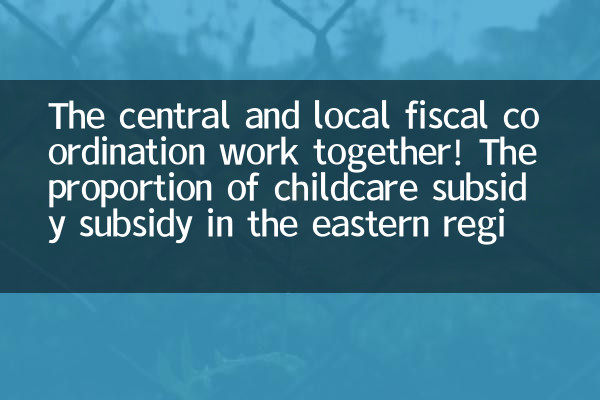The central and local fiscal coordination work together! The proportion of childcare subsidy subsidy in the eastern region is clear
Recently, the central and local fiscal coordination has made efforts to further clarify the subsidy ratio of childcare subsidies in the eastern region, aiming to alleviate the pressure on family parenting and promote long-term balanced population development. This policy has attracted widespread attention and has become one of the hot topics in the past 10 days. The following is a detailed interpretation of the policy and structured data display.
1. Policy background and main content

With the changes in my country's population structure and the fertility rate continues to decline, the central and local governments at all levels have successively introduced a series of policies to encourage fertility. The clarification of the proportion of childcare subsidies in the eastern region is one of the important measures taken by the fiscal coordination. The policy mainly covers the following contents:
1.Central fiscal subsidy ratio: For parenting families in the eastern region that meet the conditions, the central government will provide subsidies in a certain proportion, and the specific proportion will be dynamically adjusted according to the local economic development level and fiscal situation.
2.Local financial supporting measures: All provinces and cities in the eastern region need to formulate supporting policies in accordance with the central requirements, clarify the proportion of local fiscal undertakings, and ensure that subsidy funds are distributed in a timely and in full.
3.Subsidy objects and standards: The subsidy is mainly for families with two or three children, and some regions will also cover families with one child. The specific standards will be determined by local governments in combination with actual conditions.
2. Data on childcare subsidy ratio in the eastern region
The following are preliminary data on the proportion of childcare subsidies for some provinces and cities in the eastern region (as of the latest statistics):
| area | Central fiscal subsidy ratio | Local financial subsidy ratio | Subsidy objects |
|---|---|---|---|
| Beijing | 30% | 70% | Families with two children and above |
| Shanghai | 25% | 75% | Families with two children and above |
| Jiangsu Province | 35% | 65% | Families with two children and above |
| Zhejiang Province | 40% | 60% | Families with one child or more |
| Guangdong Province | 20% | 80% | Three-child family |
3. Policy impact and social response
1.Reduced family burden: The issuance of childcare subsidies directly reduces the cost of family parenting, especially for middle- and low-income families, the policy effect is significant.
2.Increased willingness to give birth: Survey data from some regions show that after the policy was introduced, the willingness of families of childbearing age has rebounded, especially the birth plan for second and third children has increased significantly.
3.Local financial pressure: Although the central government has provided some support, some local governments have great financial pressure, and how to balance expenditures and benefits has become the focus of local governments.
4. Expert interpretation and suggestions
Many experts said that the joint efforts of the central and local fiscal coordination is a key step in solving the fertility problem, but other measures are needed:
1.Improve the childcare service system: Subsidy policies need to be promoted simultaneously with the construction of childcare services to solve the problem of "no one carries children".
2.Optimize tax policies: It is recommended to give more tax exemptions to parenting families to further reduce parenting costs.
3.Dynamically adjust subsidy standards: Adjust the subsidy amount and coverage range in a timely manner according to changes in price levels and household needs.
5. Future Outlook
The clarification of the proportion of childcare subsidies in the eastern region is an important attempt by the central and local fiscal coordination. In the future, policies are expected to be further expanded to the central and western regions to form a nationwide unified fertility support system. At the same time, with the implementation and improvement of policies, my country's population structure problems may be effectively alleviated.
The introduction of the parenting subsidy policy not only reflects the country's high attention to population issues, but also provides tangible support for family childbirth. In the next step, local governments need to speed up the formulation of implementation rules to ensure that policy dividends benefit more families.

check the details

check the details